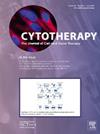ifn γ激活的MSC上的整合素α4和CCR5决定了小鼠aGVHD预防关键部位的生物分布
IF 3.7
3区 医学
Q2 BIOTECHNOLOGY & APPLIED MICROBIOLOGY
引用次数: 0
摘要
背景,经干扰素-γ (γ - MSC)活化的间充质间质细胞(MSC)表现出强大的免疫抑制特性,而未活化的间充质间质细胞仍然是临床试验的重点。大量小鼠研究表明,γ - msc可以预防造血细胞移植后的急性移植物抗宿主病(GVHD),但影响其静脉输注后分布的分子机制和活性部位尚不清楚。本研究旨在确定活性位点,并阐明控制γ - msc运输的分子和细胞机制。方法采用完全MHC错配造血细胞移植(HCT)小鼠模型。hct后24小时注射人γMSC,评估其组织定位。使用CRISPR/Cas9修饰γ - msc,并使用诱导细胞或荧光显微镜进行体外分析。用氯膦酸钠清除巨噬细胞,研究巨噬细胞在运输和GVHD预防中的作用。结果经静脉注射16小时后,γ - msc在aGVHD发生的关键部位肠相关淋巴组织(GALT)中富集。在体外,与其他SLO内皮细胞相比,γ - msc与脾脏内皮细胞的粘附能力显著增强,整合素α4在这种相互作用中起着至关重要的作用,α4敲除可使粘附能力降低94%。我们发现CCL3、CCL4和CCL5是小鼠活化T细胞条件培养基中上调的关键趋化因子,阻断这些趋化因子可共同消除γ - msc迁移。γ - msc表达CCR5敲低使γ - msc迁移减少90%。在体内,虽然γMSC对T细胞的抑制作用仍然存在,但在γMSC中α4或CCR5的敲低会破坏它们对GALT的转运,并显著预防GVHD。此外,氯膦酸脂质体消耗单核/巨噬细胞不影响γ -间充质干细胞向脾脏的运输,但会消除γ -间充质干细胞抑制gvhd的活性,这表明巨噬细胞不是运输γ -间充质干细胞所必需的,而是其治疗功能所必需的。结论在小鼠模型中,整合素α4和CCR5在γ - msc上协同表达,调控其向GALT转运,发挥免疫抑制作用,显著降低GVHD。这些发现强调了GALT定位在γ - msc疗效中的重要性,为提高γ - msc在GVHD预防中的治疗潜力提供了新的见解。本文章由计算机程序翻译,如有差异,请以英文原文为准。
Integrin α4 and CCR5 on IFNγ-activated MSC determine biodistribution to critical sites for aGVHD prophylaxis in mice
Background & Aim
Mesenchymal stromal cells (MSC) activated with interferon-γ (γMSC) exhibit potent immunosuppressive properties, yet nonactivated MSC remain the focus of clinical trials. Extensive mouse studies show that γMSC can prevent acute Graft versus Host Disease (GVHD) after hematopoietic cell transplantation, but the molecular mechanisms affecting their distribution post-IV infusion and the sites of activity remain unclear. This study aims to identify the site(s) of activity and elucidate the molecular and cellular mechanisms governing γMSC trafficking.
Methodology
A mouse model of fully MHC mismatched hematopoietic cell transplantation (HCT) was used. Human γMSC were infused 24 hours post-HCT, and their tissue localization was assessed. CRISPR/Cas9 was used to modify γMSC, and in vitro analyses conducted using IncuCyte or fluorescence microscopy. Macrophages depletion with clodronate was performed to study their role in trafficking and GVHD prevention.
Results
We observed that γMSC were enriched in gut-associated lymphoid tissue (GALT) 16 hours post-IV infusion, critical site for the development of aGVHD. In vitro, γMSC exhibited significantly greater adhesion to spleen endothelial cells compared to other SLO endothelial cells, and integrin α4 was crucial for this interaction, as α4 knockdown reduced binding by 94%. We identified CCL3, CCL4, and CCL5 as key chemokines upregulated in murine activated T cell conditioned media and blocking these chemokines collectively abolished γMSC migration. γMSC expressed CCR5 knockdown in γMSC reduced migration by 90%. In vivo, knockdown of α4 or CCR5 in γMSC impaired their trafficking to GALT and significantly the prophylactic effects against GVHD, although T cell suppression by γMSC was retained. Furthermore, depletion of monocytes/macrophages by liposomal clodronate did not affect γMSC trafficking to the spleen but abolished the GVHD-suppressive activity of γMSC, indicating that macrophages are not required for γMSC trafficking, but essential for their therapeutic function.
Conclusion
Our study reveals that the coordinated expression of integrin α4 and CCR5 on γMSC governs their trafficking to GALT, where they exert their immunosuppressive effect and significantly reduce GVHD in a mouse model. These findings highlight the importance of GALT localization in γMSC efficacy, offering insights that could inform strategies to enhance the therapeutic potential of γMSC in GVHD prevention.
求助全文
通过发布文献求助,成功后即可免费获取论文全文。
去求助
来源期刊

Cytotherapy
医学-生物工程与应用微生物
CiteScore
6.30
自引率
4.40%
发文量
683
审稿时长
49 days
期刊介绍:
The journal brings readers the latest developments in the fast moving field of cellular therapy in man. This includes cell therapy for cancer, immune disorders, inherited diseases, tissue repair and regenerative medicine. The journal covers the science, translational development and treatment with variety of cell types including hematopoietic stem cells, immune cells (dendritic cells, NK, cells, T cells, antigen presenting cells) mesenchymal stromal cells, adipose cells, nerve, muscle, vascular and endothelial cells, and induced pluripotential stem cells. We also welcome manuscripts on subcellular derivatives such as exosomes. A specific focus is on translational research that brings cell therapy to the clinic. Cytotherapy publishes original papers, reviews, position papers editorials, commentaries and letters to the editor. We welcome "Protocols in Cytotherapy" bringing standard operating procedure for production specific cell types for clinical use within the reach of the readership.
 求助内容:
求助内容: 应助结果提醒方式:
应助结果提醒方式:


